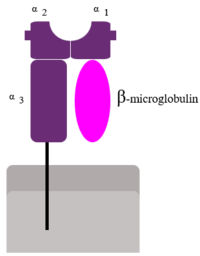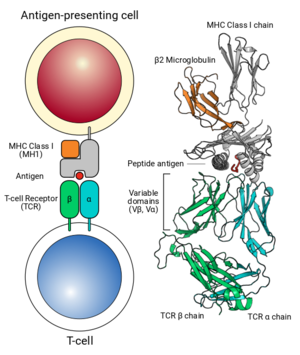User:Jeremiah C Hagler/Sandbox 2
From Proteopedia
< User:Jeremiah C Hagler(Difference between revisions)
| (5 intermediate revisions not shown.) | |||
| Line 1: | Line 1: | ||
==Protein 1: MHC Class I== | ==Protein 1: MHC Class I== | ||
| - | |||
<StructureSection load='1hhk' size='340' side='right' caption='MHC Class I' scene=''> | <StructureSection load='1hhk' size='340' side='right' caption='MHC Class I' scene=''> | ||
| - | |||
== Background Information == | == Background Information == | ||
Major Histocompatibility Complex Class I (abbreviated for obvious reasons as MHC Class I) is a key component of your immune system. The protein is a glycoprotein (protein with a sugar attached) present on all cells in your body. Its function is to show peptides (short stretches of 9-10 amino acids), both self and foreign, to the immune system. This presentation helps the immune system determine whether the body has been infected by a foreign agent (bacteria or virus). When the body is not infected with a pathogen, peptides derived from normal proteins present in your cells are presented on the Class I MHC molecule (these peptides are known as “self” peptides). These peptide-MHC combinations are ignored by the immune system, as the cells of the immune system (mainly T-cells) have been “trained” to not react to self peptides present on the MHC. However, when the body is infected with a pathogen like a virus, cells are commandeered by the virus to produce large amounts of viral proteins that will be used to make new virus. Some of these proteins are broken down by the cell into peptides, and presented on the Class I MHC molecule (these are known as “foreign” peptides). T-cells, the cells that recognize MHC Class I complexed with peptide, are trained to recognize only those MHC Class I molecules that are presenting foreign peptides--such as these protein pieces from the viral invader. The MHC Class I + foreign peptide complex is recognized differently and is key to developing an effective immune response against the pathogenic invader. | Major Histocompatibility Complex Class I (abbreviated for obvious reasons as MHC Class I) is a key component of your immune system. The protein is a glycoprotein (protein with a sugar attached) present on all cells in your body. Its function is to show peptides (short stretches of 9-10 amino acids), both self and foreign, to the immune system. This presentation helps the immune system determine whether the body has been infected by a foreign agent (bacteria or virus). When the body is not infected with a pathogen, peptides derived from normal proteins present in your cells are presented on the Class I MHC molecule (these peptides are known as “self” peptides). These peptide-MHC combinations are ignored by the immune system, as the cells of the immune system (mainly T-cells) have been “trained” to not react to self peptides present on the MHC. However, when the body is infected with a pathogen like a virus, cells are commandeered by the virus to produce large amounts of viral proteins that will be used to make new virus. Some of these proteins are broken down by the cell into peptides, and presented on the Class I MHC molecule (these are known as “foreign” peptides). T-cells, the cells that recognize MHC Class I complexed with peptide, are trained to recognize only those MHC Class I molecules that are presenting foreign peptides--such as these protein pieces from the viral invader. The MHC Class I + foreign peptide complex is recognized differently and is key to developing an effective immune response against the pathogenic invader. | ||
| Line 10: | Line 8: | ||
| - | [[Image:MHC_Class_1.png|200px|left|thumb| Two subunits of MHC I (alpha--contains alpha 1, 2 and 3 domains--and Beta-microglobulin)]][[Image: | + | [[Image:MHC_Class_1.png|200px|left|thumb| Two subunits of MHC I (alpha--contains alpha 1, 2 and 3 domains--and Beta-microglobulin)]][[Image:tcr_example_labelled.png|300px|center|thumb| Interaction of MHC Class 1-Antigen complex with TCR]] |
<br> | <br> | ||
| + | == Structure == | ||
| + | <scene name='71/711668/Wireframe_mhc1/2'>Click to open MHC Class I</scene> | ||
<br> | <br> | ||
| - | <br> | ||
| - | <br> | ||
| - | <br> | ||
| - | <br> | ||
| - | <br> | ||
| - | == Sructure == | ||
| - | <scene name='71/711668/Wireframe_mhc1/2'>Click to open MHC Class I</scene> | ||
1. What color is used for the alpha helices? | 1. What color is used for the alpha helices? | ||
<br> | <br> | ||
| Line 32: | Line 25: | ||
Hmm...but just how tight does the fit of the peptide look in the MHC groove? Now, open the <scene name='71/711668/Mhc_antigen_binding_pocket/1'>MHC Class I binding domain model</scene>. Here you are seeing only subunits D and F from the previous image. | Hmm...but just how tight does the fit of the peptide look in the MHC groove? Now, open the <scene name='71/711668/Mhc_antigen_binding_pocket/1'>MHC Class I binding domain model</scene>. Here you are seeing only subunits D and F from the previous image. | ||
<br> | <br> | ||
| - | 6. What is different - or - where did all the space go? To get a feel for this new view and how it relates to the previous model, right click on the 3D image (or ctrl-click for Mac users), then: | + | 6. What is different - or - where did all the space go? To get a feel for this new view and how it relates to the previous model, click on the "popup" button on the bottom right of the structure box. A new window with the MHC 3D structure will open. Then, right click on the 3D image (or ctrl-click for Mac users), then: |
| + | <br> | ||
a. "Select"-->"all" | a. "Select"-->"all" | ||
<br> | <br> | ||
| - | b. " | + | b. "Style"-->"structures"-->"backbone" |
| - | + | ||
| - | + | ||
<br> | <br> | ||
Now this looks a lot more like the previous MHC model image from parts 1-5. | Now this looks a lot more like the previous MHC model image from parts 1-5. | ||
| + | |||
| + | Click here to reload original:<scene name='71/711668/Mhc_antigen_binding_pocket/1'>MHC Class I binding domain model</scene> | ||
Current revision
Protein 1: MHC Class I
| |||||||||||


